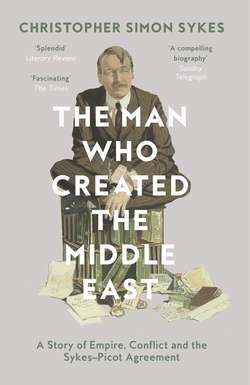The Man Who Created the Middle East: A Story of Empire, Conflict and the Sykes-Picot Agreement

Реклама. ООО «ЛитРес», ИНН: 7719571260.
Оглавление
Christopher Sykes Simon. The Man Who Created the Middle East: A Story of Empire, Conflict and the Sykes-Picot Agreement
Copyright
Dedication
Contents
Introduction
Prologue. An Exhumation
Chapter 1. The Parents
Chapter 2. Trials and Tribulations
Chapter 3. Through Five Turkish Provinces
Chapter 4. South Africa
Chapter 5. Coming of Age
Chapter 6. Return to the East
Chapter 7. Family Life
Chapter 8. A Seat in the House
Chapter 9. War
Chapter 10. Kitchener and the Middle East
Chapter 11. The Sykes–Picot Agreement
Chapter 12. Zionism
Chapter 13. The Balfour Declaration
Chapter 14. Worked to Death
Epilogue. The Legacy
Acknowledgements
Bibliography
References and Notes on Sources
Index
Also by Christopher Simon Sykes
About the Publisher
Отрывок из книги
‘… of this I am sure, we shall never in our lives meet anyone like him.’
.....
However snobbish and scheming Jessie’s mother may have been, she had a soft spot for her grandson, and was increasingly worried about the effect that both the general atmosphere at Sledmere, and his parents’ frequent absences abroad might be having on him. They were often away for months at a time, and she saw how he was left in a household with eleven female servants, and only three males, around whom he apparently ran rings: ‘if he remains for much longer surrounded by a pack of admiring servants,’ continued his grandmother, ‘and with no refined well-educated person to look after him … and check him if he is not civil in his manners, he will become completely unbearable … When he goes to Sledmere he is made the Toy and idol of the place and each servant indulges him as they please.’29 His burgeoning ego needed stemming, and she felt strongly that the way to achieve this was to engage a tutor for him. She made her feelings known to Jessie. ‘He is a charming child and most intelligent and precocious, which under the circumstances makes one tremble, for there is no doubt that he is now quite beyond the control of women.’30 For a start, engaging a tutor for Mark would give him a male companion other than the elderly Grayson, to ease the loneliness of his life at Sledmere. Jessica herself admitted this in a letter to Lucien, on the eve of another trip abroad, this time to Jerusalem. ‘The house is to be quite shut up, all the servants that are left to be on board-wages, the horse turned out, and poor little Mark left by himself … and not a soul in whom I have any confidence in the neighbourhood to look after him.’31 She set out on her travels having even forgotten to buy him a birthday present, writing to Lucien in February, from Jerusalem, ‘March 16th is Mark’s birthday – it would be very kind of you if you would send him a little toy from Paris for it – as I fear the poor child will get no presents, and he would be so delighted.’32
Up till now, the elementary part of Mark’s education had taken place at Sledmere village school. Here he had learned to write and spell under the worthy schoolmaster, Mr Thelwell, but had shown little aptitude for other studies: ‘he was not a diligent scholar,’ commented Thelwell; ‘book-work was drudgery; but having great powers of observation and a splendid memory, he stored a mass of information’.33 Almost everything else he had learned, he had done so at his mother’s knee, so in 1887 Jessie gave in to her mother and hired a young tutor, Alfred Dowling, whom Mark nicknamed ‘Doolis’. No sooner had he arrived than his new charge had dragged him up to see the Library, which he said was the only ‘schoolroom’ he ever loved. ‘I wish you could see the library here,’ he was later to write to his fiancée, Edith Gorst, ‘it is really very interesting. Going into a library that has stopped in the year 1796 is like going back a hundred years. Everything is there of the time. In the drawers is the correspondence dated for that year. In the cupboards are the ledgers and rent rolls of the last century. If I stayed in it long I, too, would be of the last century, because everything there is of the same date, from fishing rods to the newspapers.’34
.....